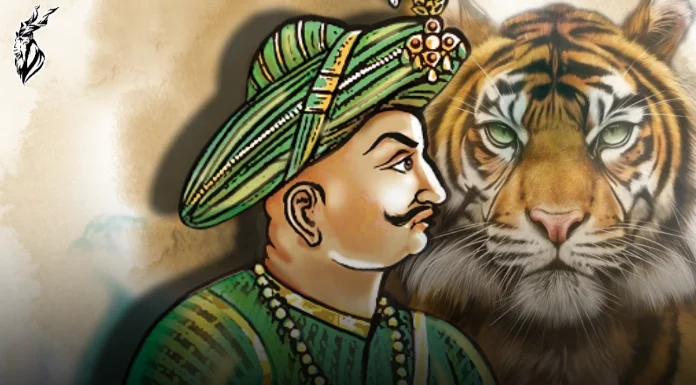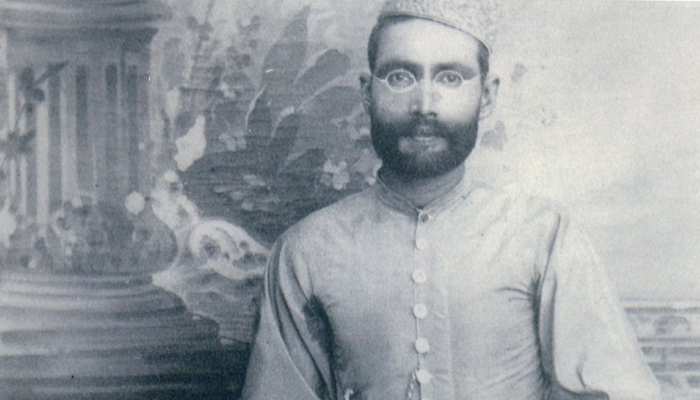– Shams Tahir
The contributions of Muslim freedom fighters to India’s independence struggle are a testament to the inclusive nature of the movement. These leaders, whether through armed resistance, non-violent protest, or social reform, played pivotal roles in challenging British rule and shaping the future of India. Their legacy is a reminder of the diverse and collective effort that went into achieving India’s independence, and their stories continue to inspire generations in the ongoing pursuit of justice, equality, and unity of this Ummah.
According to historical references 65% of those who stood, fought and sacrificed against the British for Indian’s independence were Muslim freedom fighters. Although nowadays almost all of them are forgotten by our own people. Here are some of them for us to remember.
1. Early Pioneers: Tipu Sultan and Sir Syed Ahmed Khan.
 Tipu Sultan: The Tiger of Mysore (1751-1799)
Tipu Sultan: The Tiger of Mysore (1751-1799)
The resistance against British rule in India dates back to the 18th century, with figures like Tipu Sultan, the ruler of Mysore, who is often regarded as one of the earliest freedom fighters. Tipu Sultan, known as the “Tiger of Mysore,” resisted the British East India Company’s expansion in southern India through several wars. He allied with the French and other local rulers in his quest to protect his kingdom from British domination. Tipu’s resistance was ultimately unsuccessful, as he was killed in the Fourth Anglo-Mysore War in 1799, but his legacy as a symbol of resistance against colonialism remains significant. In the 19th century, Sir Syed Ahmed Khan emerged as a key figure in the socio-political landscape of India. Although not a freedom fighter in the traditional sense, his contributions laid the groundwork for the political awakening of Indian Muslims. Sir Syed founded the Aligarh Muslim University, which became a hub for modern education and political thought among Muslims. His efforts to promote education and social reform helped prepare the Muslim community to engage in the freedom struggle in later years.
2. The Revolt of 1857: Maulana Fazl-e-Haq Khairabadi and Bahadur Shah Zafar.

Maulana Fazl-e-Haq Khairabadi (1797-1861)
The Revolt of 1857, often referred to as India’s First War of Independence, saw significant contributions from Muslim leaders. Maulana Fazl-e-Haq Khairabadi was a prominent Islamic scholar and poet who issued a fatwa (religious decree) against British rule, urging Muslims to join the revolt. He was subsequently arrested and exiled to the Andaman Islands, where he continued to inspire resistance through his writings. Bahadur Shah Zafar, the last Mughal emperor, also played a symbolic role in the 1857 uprising. Though his power was largely ceremonial by this time, Zafar was declared the leader of the revolt by the insurgents. His involvement lent a sense of legitimacy to the movement, although the uprising was eventually crushed by the British. Zafar was captured, tried, and exiled to Rangoon, where he died in 1862. Despite the failure of the revolt, it served as an inspiration for future generations of freedom fighters.
3. Reshmi Rumal Movement

Maulana Mehmood Hasan aka Sheikh-ul-Hind, the mastermind behind the Silk Letter Movement (1851-1920)
Also known as the “Silk Letter Conspiracy” (Reshmi Rumaal Tehrik), was a significant yet lesser-known episode in the Indian freedom struggle against British colonial rule. This movement was orchestrated by the prominent Islamic scholar and freedom fighter Maulana Mahmood Hasan, who later became the first president of the Jamiat Ulema-e-Hind. It took place during World War I, a time when various anti-British activities were emerging across the globe. The movement was primarily driven by a group of Indian Muslim scholars who aimed to overthrow British rule in India by seeking assistance from foreign powers, particularly the Ottoman Empire, Afghanistan, and Germany.
Maulana Mahmood Hasan, along with other scholars like Maulana Obaidullah Sindhi, planned to launch an armed rebellion against the British. The idea was to establish a government-in-exile in Afghanistan and then use that base to invade India with the help of Afghan and Turkish forces. To coordinate this effort, Maulana Obaidullah Sindhi was sent to Kabul, Afghanistan, to seek support from the Afghan Emir, while Maulana Mahmood Hasan traveled to the Hejaz (modern-day Saudi Arabia) to garner support from the Ottoman Empire.
The movement gets its name from the method used to communicate the plans. The conspirators wrote their messages on pieces of silk cloth, which were then sent to different leaders and revolutionaries. These “silk letters” outlined the strategy for the rebellion, including the coordination between Indian revolutionaries and foreign powers. Unfortunately for the movement, the British intelligence services intercepted these silk letters before the plan could be put into action. The letters were discovered in 1916, leading to the arrest of Maulana Mahmood Hasan and several others involved in the conspiracy. Maulana Hasan was imprisoned in Malta by the British, where he remained until the end of World War I.
While the Reshmi Rumal Movement did not achieve its immediate goals, it was significant for several reasons. It highlighted the role of Indian Muslims in the freedom struggle and demonstrated the willingness of Indian revolutionaries to seek international alliances against British rule. The movement also inspired later generations of freedom fighters and contributed to the broader narrative of resistance against colonialism. In retrospect, the Reshmi Rumal Movement is an important chapter in the history of India’s fight for independence, illustrating the diverse and global dimensions of the struggle against British imperialism.
4. The Khilafat Movement: Maulana Abul Kalam Azad and Muhammad Ali Jinnah
Maulana Mohammad Ali Johar (1878-1931) & Maulana Shaukat Ali Johar (1873-1938), the pioneers behind Khilafat Movement
In the early 20th century, the Khilafat Movement emerged as a significant moment in the Indian freedom struggle. The movement, led by leaders like Maulana Abul Kalam Azad and the Ali brothers (Maulana Muhammad Ali Jauhar and Maulana Shaukat Ali), sought to protect the Ottoman Caliphate, which was seen as the symbolic head of the Muslim world. Although the Khilafat Movement was initially focused on an international issue, it quickly merged with the Indian independence struggle, leading to widespread Muslim participation in the non-cooperation movement against British rule. Maulana Abul Kalam Azad, in particular, became a towering figure in India’s freedom struggle. A scholar, journalist, and political leader, Azad was a staunch advocate of Hindu-Muslim unity and opposed the partition of India. As a prominent member of the Indian National Congress, he played a crucial role in mobilizing support for the freedom movement across religious lines. Azad later became the first Minister of Education in independent India, where he continued his efforts to promote unity and progress through education. Muhammad Ali Jinnah, initially a member of the Indian National Congress, was another significant Muslim leader who fought for India’s freedom. Though Jinnah later became the leader of the All India Muslim League and advocated for the creation of Pakistan, his early contributions to the freedom struggle, particularly during the Lucknow Pact of 1916, were aimed at achieving a united India. His evolution from a proponent of Hindu-Muslim unity to the architect of Pakistan reflects the complex dynamics of the freedom movement.
In the contemporary context, the collective memory of these figures seems to have faded, overshadowed by religious and political divides that have emerged in post-independence India. The marginalization of their stories is not just a loss to the Muslim community but a loss to the entire nation, as it weakens the understanding of India’s diverse and inclusive fight for freedom. Recognizing and honoring these forgotten heroes is crucial not only for historical accuracy but also for fostering unity and mutual respect in a country as diverse as India.

